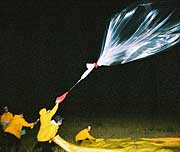Field observations are an important part of theory. Scientists using equations and computers to model the atmosphere can't be sure their ideas are sound until they can prove them through observation. When taking special instruments and sensors into the field to study the weather, scientists look for specific processes, like how tornadoes form or how electricity discharges in clouds. Sometimes what researchers observe in the field leads back to more theoretical studies and new hypotheses. Multiple data sets provide ground truth and a framework for researchers to build a coherent picture of storm structure. A successful field observing program requires collaborating with other scientists, sharing costly instruments and equipment, and sharing the collected data.
Observing systems can be categorized in several ways. Two such ways are 1) fixed vs mobile and 2) in situ vs remote. The first category simply means some parts of the system are permanently located, like a WSR-88D radar. Other parts can be positioned very close to where the weather is occurring, like a mobile ballooning vehicle. The second category refers to how the observing system makes its measurements. An in situ measurement is taken right where the sensor - a wind vane perhaps - is located. Remote systems make their measurements on far away objects. For instance a radar beam focuses on distant cloud particles. More about categorizing observing systems »
Fixed Observing Systems
Large-scale field programs make use of data that is collected routinely within the study area. This data is used by project scientists in advance of operations to help determine a region of interest, during operations and data collection periods, and after the field phase is completed to give a complete picture of the mission.
- Oklahoma Lightning Mapping Array
- WSR-88D Radars
- Profilers
- Mesonets
Mobile Observing Systems
By being in the right place at the right time, mobile facilities can document weather in and near the storm environment. Mobile mesonet rooftop weather observations, SMART radar base scans, soundings and location information are broadcast over a mobile digital radio network to the field coordinator.
- Mobile ballooning laboratories
- Mobile mesonet vehicles
- SMART-Rs mobile Doppler radars
Field Projects
Successful large-scale field projects require good science, adequate funding, meticulous coordination, and months of planning. The largest driving force is the need for answers to fundamental scientific questions.
- TELEX, IHOP
- Past projects
Field Observing Facilities Support
- The Field Observing Facilities Support group oversees and provides support for a portion of NSSL's observing facilities. Included are mobile, deployable, and fixed-site facilities for use by researchers.

